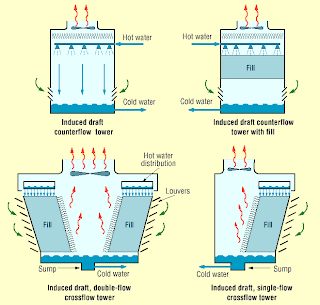A cooling tower is a heat rejection device, which extracts waste heat
to the atmosphere though the cooling of a water stream to a lower
temperature. Common applications for cooling towers are providing
cooled water for air-conditioning, manufacturing and electric power
generation. The generic term "cooling tower" is used to
describe both direct (open circuit) and indirect (closed circuit) heat
rejection equipment. A direct, or open-circuit cooling tower is an
enclosed structure with internal means to distribute the warm water
fed to it over a labyrinth-like packing or "fill." The fill
may consist of multiple, mainly vertical, wetted surfaces upon which a
thin film of water spreads. An indirect, or closed circuit cooling
tower involves no direct contact of the air and the fluid, usually
water or a glycol mixture, being cooled. In a counter-flow cooling
tower air travels upward through the fill or tube bundles, opposite to
the downward motion of the water. In a cross-flow cooling tower air
moves horizontally through the fill as the water moves downward.
Cooling towers are also characterized by the means by which air is
moved. Because evaporation consists of pure water, the concentration
of dissolved minerals and other solids in circulating water will tend
to increase unless some means of dissolved-solids control, such as
blow-down, is provided. Some water is also lost by droplets being
carried out with the exhaust air (drift).




